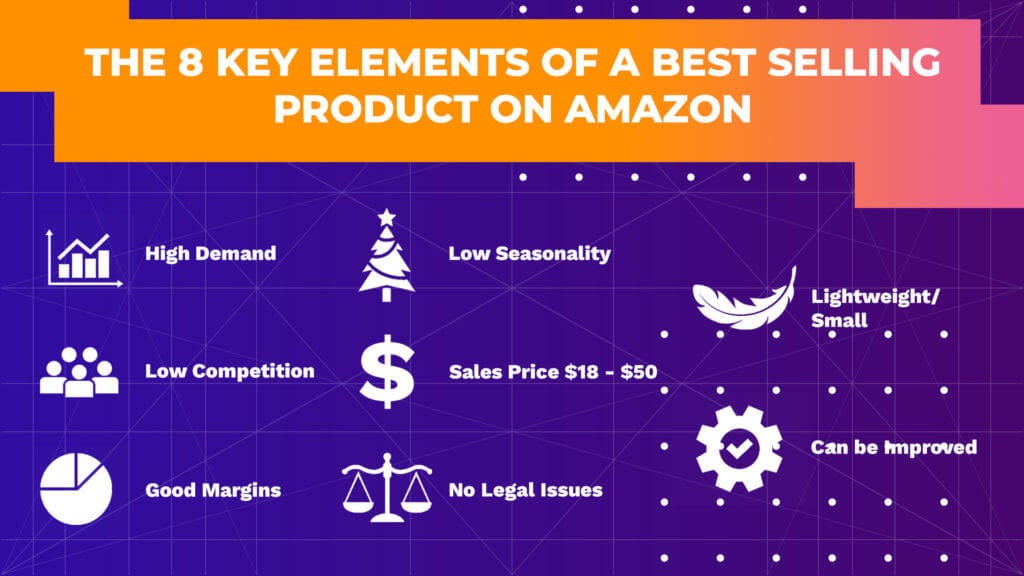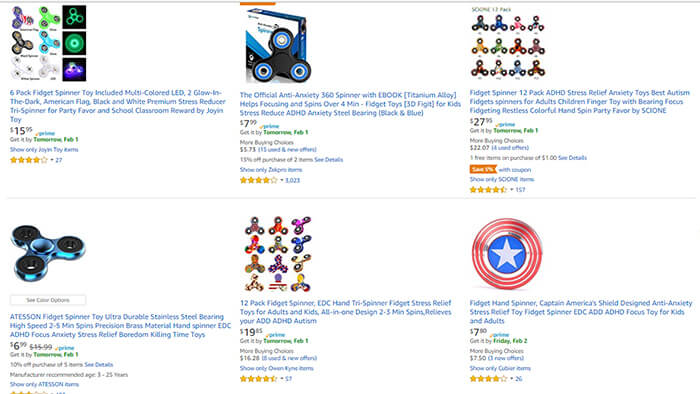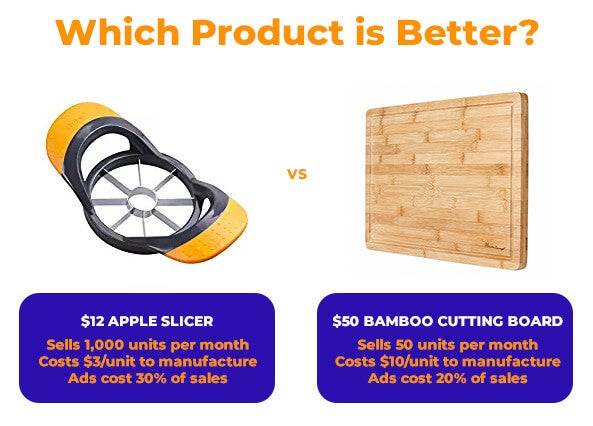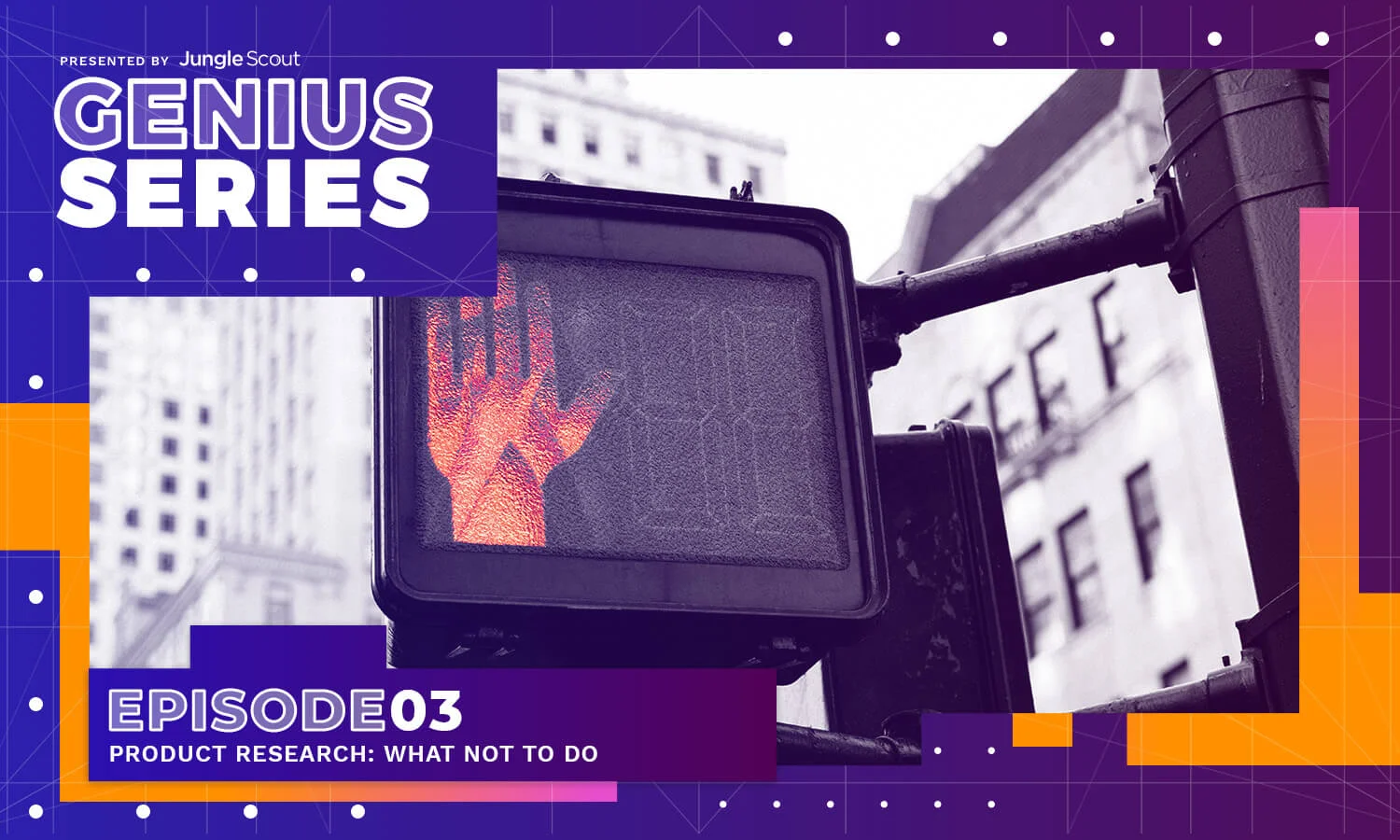Last week, we discussed the basics of Amazon product research and product hunting in our second episode of the Genius Series. If you didn’t already watch it, be sure to go back and review. Plus, make sure you do your homework! This week, I want to go a little more in-depth regarding the process of finding products to sell on Amazon and cover some “what not to do” elements of product research.
Note: Learn what else NOT to do as an Amazon seller in our article, the 10 Most Expensive Mistakes New Amazon Sellers Make.
10 Things You Should Not Do During Amazon Product Research
#1 – DON’T Only Focus on Demand/Average Sales
There’s nothing more exciting than finding a product niche that’s selling hundreds, if not thousands, of units per month. Unfortunately, the average sales volume–or demand–is only one piece of the puzzle. In addition to demand, you still have to consider competition, costs, improvability, seasonality, and more. Failure to factor in those important elements can cost you thousands. Believe me, I’ve made the mistake before myself.

One tool that can help you figure out whether or not a product is worth it is our opportunity score. Each time you do Amazon product research using Jungle Scout, the niche is rewarded a score based on our own bulletproof algorithm. We suggest that you find products that rank 7 or more.

Remember, there are at minimum eight different factors to consider when doing Amazon product research. Here’s the graphic again if you aren’t sure what those are:

#2 – DON’T Ignore Your Product’s Category Requirements
Maybe this situation sounds familiar. You’ve sourced an awesome product on Amazon (using Jungle Scout — an all-in-one platform for selling on Amazon — of course), know that it’d be totally killer and make you a ton of sales and super-duper rich, but lo-and-behold you can’t sell it because of Amazon restricted categories. Sad trombone!
Amazon has close to 20 categories it considers “off limits” for the average seller. There are four types of gated categories:
- Specialist/collectible categories. These are categories that only niche experts should sell in, as they typically have high quality standards. Examples include collectible coins, sports memorabilia, and fine art.
- Hazardous/high-liability categories. Amazon doesn’t want a bunch of law suits on their hands, therefore the categories with products that could prove dangerous to shoppers (and FC employees, too) are off-limits to those without an approval. Examples include major appliances, cosmetics, food, and even toys/games.
- High-maintenance categories. Some product categories are definitely geared towards more advance sellers as they come with high return ratios, sizes, colors, and more. Amazon just wants to make sure the seller knows what they’re getting into before they start selling these items. Fashion and clothing fit into these categories.
- Expensive/high-quality categories. Finally, some items are far more expensive than the typical $0-$100 price points of other Amazon products. It takes an expert to sell these items. These categories include fine art, watches, and jewelry.
To sell in these categories, you must become “ungated.” Each gated category has its own set of requirements. You can read more about getting into restricted categories in our blog post on the topic.
One trick we like to tell new sellers is that before you ever even place a deposit on products on Alibaba or wherever you’re sourcing, try setting up a listing for the product first. You may have to purchase a UPC to do it, but trust us, the $25 spent buying a UPC is a lot better than having a few thousand dollars worth of product you can’t sell through FBA.
#3 – DON’T Just “Copy-and-Paste”
A few years ago, it was pretty easy to find a product niche, see what what top sellers were doing to sell those products, and just totally “copy and paste” those products. Source it cheap, throw on your own brand name, stuff in a white box, and watch it go. Because of this, you’d have an entire first page of search results all with the exact same product over and over again. Needless to say, Amazon wasn’t crazy about that dynamic.
Since then, Amazon’s A9 algorithm has gotten a lot smarter. Now it knows to look for products that are just different enough while ranking them. That’s why you can no longer just “copy-and-paste” a product niche. Not if you want to succeed, that is.

When doing Amazon product research, be sure to find a way to make your product stick out. Consider Seth Godin’s concept of the purple cow.

If you’re driving down a country road, you might remark the first time you see a brown cow chewing grass out your window. But after a few more brown cows, you stop turning your head. Been there, done that.
But wait–now there’s a purple cow among those brown cows. You’ve never seen anything like it. You stop the car, get out, take a few pictures, share it all over social media. Sure, it’s still a cow, but hey! It’s purple.
That’s the kind of product you want to create. One that still easily fits into the product niche, but also turns heads.
#4 – DON’T Get Tricked By Seasonal Sales Figures
Back when I started with Amazon private label, I made a huge mistake with my second product. First, I violated the first DON’T on this list–I only focused on the sales figures and not the competition. But second, I picked a product that only sells during the summer. Not only did I have a heckuva time trying to sell the things during the high season, but once it started getting cold I was getting a weekly goose egg. To this day, I have over 1,000 watermelon slicers sitting in my garage.

When doing Amazon product research, if you aren’t sure whether or not the product you’re tracking is a seasonal item, simply click the Google Trend Report button located in the bottom left of the Chrome extension.
#5 – DON’T Just Pick One Product
Launching an Amazon private label business is more than just picking a few profitable products and throwing them up there and seeing what sticks. It’s about building a brand. Not only will building a brand give synergy to your overall product line, but it will help you get bonus features in seller central like brand registry, enhanced brand content, and storefronts. And if you use outside marketing channels, it will help you segment your audience even more and give them new buying opportunities.

Of course, you don’t have to actually invest in more than one product when you’re starting out. But it pays to have a strategy in place. As you perform Amazon product research for your first product, consider ways to extend your product line in the future. Research those products, too. And continue to track them alongside your first product.
Speaking of which…
#6 – DON’T Stop Tracking Your Product Even If You’ve Launched It
The biggest mistake we see time and time again at Jungle Scout are people who find a product and dump the product tracker once they’re finished with the Amazon product research phase. Not only should a seller start thinking about products 2, 3, and 4 after they’ve discovered their first product, but the Amazon marketplace is constantly changing. There’s no telling what could happen in the 30-60 days from the time you put down your deposit to when your goods actually arrive.
Remember my watermelon slicer horror story from before? In the time it took to manufacture and import my products (roughly 45 days), over 200 new sellers entered the market. What was once a opportunity 8 product quickly turned into an opportunity 2. Had I continued tracking the watermelon slicer, I may have known ways to pivot and save myself thousands of dollars. Instead, I just sent the products along the way to the nearest FC without knowing any better. It wasn’t until over 300 promo giveaways later with zero movement in the rankings did I discover I was getting smushed by a whole herd of other sellers trying to sell the same thing.
Recently, this almost happened again with another product of mine. I was looking to expand my product line and thought that adding a variation of one of my top selling products would double my profits. However, I discovered that what was once a category 7 product niche was now only a 4. Thanks to the product tracker, I was able to catch this in time and avoid another costly mistake.
#7 – DON’T Assume You’re The Only Person Who’s Found The Product
Sometimes, even if you’ve found the coolest product in the world through effective Amazon product research–and you’re going to hate to hear this–you need to wait. Give it a week or two. See how the market plays out. And be sure to track the product the entire time.
Once more, the watermelon slicer story comes to mind (I know, I know… but I was traumatized, okay!) Had I just waited another week or two and tracked the product, I would have seen the other sellers filling in. To think that I was the only person who’d discovered a 1,000/month product niche was just arrogant.
You’ll hear us time and time again at Jungle Scout that Amazon private label is super profitable, and still one of the most profitable ways to make money from home–but it’s not some get-rich-quick scheme. Those who are patient and bide their time will be the ones who discover success and profits.
“A lack of patience in trifling matters might lead to the disruption of a great project.” – Confucius
#8 – DON’T Forget to Estimate Your Return on Investment
This is a throwback to the first don’t (focusing on sales only), but it’s worth mentioning because I don’t think it gets said enough. It doesn’t matter how many units you’re selling if you’re earning lousy margins and taking a long time to earn back your initial investment.
Consider this:

At first glance, the apple slicer seems like the better product, right? After all, it could potentially earn $12,000 per month in sales revenue vs the $2500 that the bamboo cutting board might earn.
But let’s dig a little deeper:
(Note: I’ve simplified expenses and costs a little for the sake of the experiment.)
The Apple Slicer
- The apple slicer sells roughly 1,000 units per month on average.
- It costs $3 per unit to purchase and import the apple slicer.
- To have enough products for three months worth of sales, you will need to purchase 3000 apple slicers, for a total investment of $9,000.
- On average, apple slicers sell for $12 on Amazon.
- Advertising costs are roughly 30% of sales.
- Amazon takes 15% for referral fees and another $2.99 to ship your product.
- After 12 months, you earn $144,000 in revenue from your apple slicer.
- But, after subtracting fees, ad costs, and cost-of-goods sold, you gross $7,200.
- That’s a return-on-investment of 80%. Not bad, right?
The Bamboo Cutting Board
- The bamboo cutting board sells roughly 50 units per month.
- It costs $10 per unit to purchase and import the bamboo cutting board.
- To have enough products for three months worth of sales, you will need to purchase 150 bamboo cutting boards, for a total investment of $1500. Unfortunately, the lowest MOQ you find is 200 units, so you have to spend $2,000.
- On average, the bamboo cutting board sells for $50 on Amazon.
- Advertising costs are roughly 20% of sales.
- Amazon takes 15% for referral fees and another $6.95 to ship your product.
- After 12 months, you earn $30,000 in revenue from your bamboo cutting board.
- But, after subtracting fees, ad costs, and cost-of-goods sold, you gross $9,330.
- That’s a return-on-investment of 465%!
80% return on investment versus 465%. Which one sounds like a better deal to you?
Obviously, the bamboo cutting board is the winner here. Not only are you making your product dollar go further, but you’re spending a whole lot less money to get started. As a rule of thumb, I try to find products that will net me 4 to 5 times my original investment in the first 12 months.
#9 – DON’T Fail to Create a Marketing Strategy in Advance
Marketing is a huge piece of Amazon private label sales, so it’s best to start early, even while you’re doing the initial Amazon product research.
Amazon PPC is probably the best cost-per-click advertising utility I’ve ever used. It’s simple, elegant, and frankly, kind of cheap, especially when you factor in Amazon’s crazy high conversion rates. However, putting all your apples in the Amazon PPC basket can be a costly mistake.
If you really want to succeed and build a brand and become a #freedombuilder then I highly recommend marketing outside of Amazon, too. There’s plenty of ways to do it, but some of the most popular (and cheap) methods I’ve discovered include using Kickstarter to launch your product, putting up pics on Instagram, sending samples to influencers, and giving away promos on deal sites.

For more cool marketing methods, be sure to read this article that outlines 5 ways to market your product outside of Amazon.
#10 – DON’T Be Afraid to Take Action
Finally, and most important of all, don’t be afraid to take action. It can be pretty scary diving off the entrepreneurial cliff and into the world of Amazon selling. I’ve been there myself.
Note: If finding and creating your own product seems like too big of a first step, an alternative method like dropshipping may be the introduction to selling on Amazon that you’ve been looking for.
I nearly canceled my first product back in 2015. True story. After a ton of Amazon product research, then going back and forth for months on the product design, my vendor informed me that the leather I’d requested was out of stock and they’d have to substitute another. At the time, I was already biting my nails about the whole deal. To me, this was a way out.
Fortunately, I decided to mush on. A month later the product arrived and I launched it. Within five days, it had earned back my original investment and to this day remains my top-seller. It wasn’t the best product I ever launched by any means, but it was the first and it’ll always be my baby.

That’s the cool thing about the Jungle Scout, #freedombuilders, and Genius Series communities. We’re here to help you! It’s our mission to find more aspiring entrepreneurs like us and help them get the lives they deserve. So please please PLEASE don’t ever hesitate to ask for help.
. . .
How to Become an Amazon Selling Genius!
The Genius Series is a free in-depth guide where some of the top Amazon minds will teach you how to effectively sell your own private label products on Amazon, and it’s completely guided by YOU, the Amazon selling community!
You spoke, we listened, and here we are to present an all star series for 2018.
In addition to Amazon product research, we will cover sourcing, importing, and marketing your own private label products.
You can head over to the Genius Series page below, and sign up to get the latest updates on when new sessions are coming up. Some of the sessions will be live, so we’ll be sure to let you know ahead of time.
See you around!

 26 Comments
26 Comments
26 comments on “How to Find Top Products to Sell on Amazon”